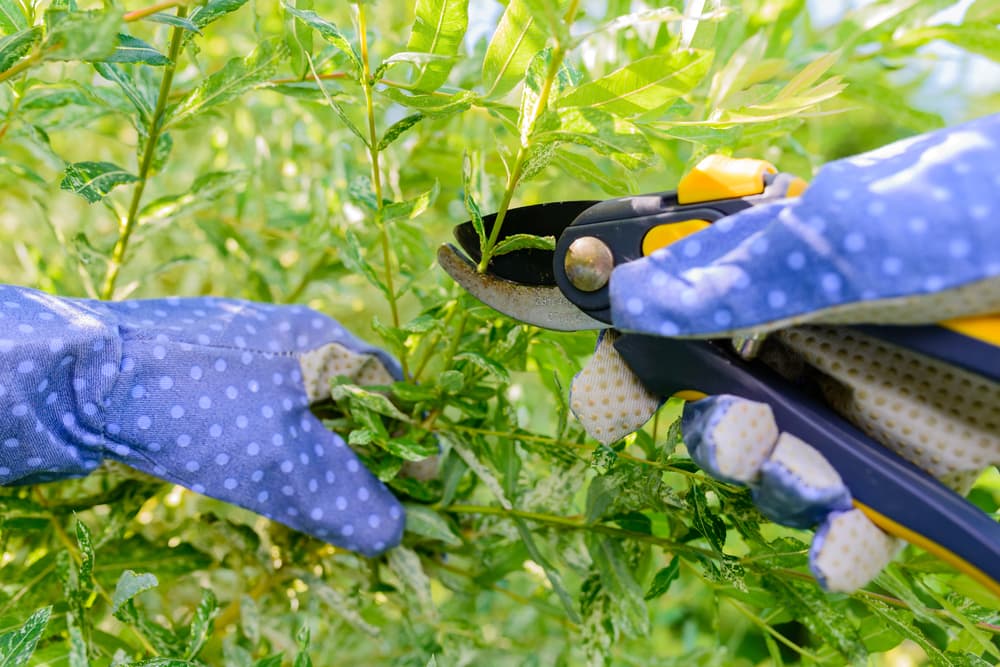Light Pruning Is Possible On Mature Willows; Pollarding Schemes Are More Complicated


Elizabeth is a Permaculture Garden Designer, Sustainability Consultant and Professional Writer, working as an advocate for positive change. She graduated from the University of St. Andrews with an MA in English and Philosophy and obtained a Diploma in Applied Permaculture Design from the Permaculture Association.
Reviewed By DAN ORI

Dan has over 27 years’ under his belt caring for plants and gardens. Working as a Horticultural Instructor and Consultant, he draws on a diverse range of experience that includes working as a Head Gardener, Tree Surgeon, Garden Centre Trouble Shooter, and writer of academic papers. Dan has a Level 3 Diploma in Horticulture and is currently a candidate for the RHS’s most prestigious award – The Master of Horticulture.
IN THIS GUIDE
WILLOW GUIDES
Container Growing
Pruning
Varieties
– Corkscrew
– Flamingo
– Weeping
Plants in the Salix genus, commonly called ‘Willows’, are deciduous trees that can often grow well in our temperate climate.
Willows can be great choices for many UK gardens, but it is important to understand how to care for them correctly – and pruning is one important area to consider.
| Difficulty | Easy |
| Equipment Required | Secateurs, pruning shears, a saw |
| When To Prune | Winter or early spring |
Do Willow Trees Need To Be Pruned?
Many mature willow trees fall into RHS Pruning Group 1 and do not require much pruning at all, as they naturally retain a well-shaped framework and form.1Shrubs and trees: light pruning. (n.d.-d). Royal Horticultural Society. Retrieved March 27, 2023, from https://www.rhs.org.uk/plants/types/trees/trees-shrubs-light-pruning
There is a wide variety of different willows that grow in UK gardens in a range of forms and sizes.
Willow species and cultivars can be extremely large trees or relatively small shrubs, with a range of sizes in between.

So, when growing willow in its natural form, it is important to choose one suited to the size of your space.
It can be challenging to keep a mature willow tree in check and you cannot really make major changes to the structure and size of a mature standard willow tree.
“You may find it hard to find a professional who will want to undertake subtle pruning of large willow trees because the branches can snap easily,” shares Master Horticulturist Dan Ori.
“If you undertake pruning never climb a tree or rest a ladder against its branches. My best advice for a large tree is to pick the right species for the spot, prune out poor growth when the tree is young, and for anything else, get a tree surgeon in.
“Remember to be realistic about what can be pruned due to the snapping tendency of its branches.”
A little light pruning is possible on mature trees, but it is generally best to keep this to a minimum, whilst some pruning may be undertaken to shape a young willow while it is still small.
However, things get a little more complicated when we look at willows that are grown for coppice or pollarding schemes.

A number of willows are not grown as standard trees with a single trunk but are instead cut back more severely, in order to encourage the formation of thin whips that can be used in a wide range of ways.
When willows are grown in a pollarding type system, they are cut back hard on a regular basis every 3-4 years depending on the species chosen, the yields desired and what they are to be used for.
“Coppicing is not common and it is not suitable for some willow types,” says Dan.
“Coppicing is taking the tree down to a stump allowing new stems to grow from it. Some people will mistakenly refer to pollarding as coppicing due to the similar approach of cutting back hard.”
Another thing to consider is that certain varieties of willow can also be trained to form structures or barriers, which will require more pruning.
When To Prune Salix
Willows can bleed sap when pruned during the growing season.
Therefore, it is best to prune in the late winter or in early spring, either while they are still dormant or just as new growth emerges.
Initial shaping and maintenance pruning on standard willow trees is generally carried out during the dormant phase and many species are also coppiced during this time.

However, varieties of willow grown for colourful stems are typically pruned in early spring, just as new growth begins to emerge.
The only time when a little pruning may be carried out on salix species in summer is when they are being grown as a living hedge or have been trained into another structure.
In such cases, some summer pruning may be required in addition to winter pruning to keep the shape of the structures.
How To Prune Willows
While many willow trees won’t need much pruning at all, it is important to consider the specific salix you are growing and to make sure that you adopt the right approach for the variety, stage of growth and what you are aiming to achieve.
Small Trees
When shaping a young willow tree to become a standard tree, you will typically select a central leader showing strong upright growth and make sure that you prune out any competing stems.

Any damaged branches should be removed, along with those that grow upwards instead of outwards or those which are overcrowded.

The aim is to create a clear, evenly-spaced structure of well-placed branches.
Mature Trees
Mature willow trees can and should largely be left to their own devices where possible.
However, it is a good idea to check over the tree in winter and to undertake simple light maintenance pruning by removing any branches that are dead, damaged or diseased and those that are rubbing against one another.
Where, for aesthetic reasons, you wish to shorten branches, you can do so sparingly, as long as you always cut just above a twig or leaf bud.

Weeping willow forms are particularly popular in many gardens.
Weeping branches can sometimes reach right down to the ground, so you may wish to shorten these for practical or aesthetic ones.
You can shorten these as required by, again, cutting just above a leaf bud.
Coppicing, Pollarding Or Stooling
A number of salix species are ideal for use within a coppicing or pollarding scheme and can often respond well to being cut back hard.
Coppicing and pollarding are techniques often used when pruning willows to encourage the formation of new growth on multiple stems.
We may wish to undertake this form of pruning in order to obtain thin willow branches, also known as whips, for use in basketry or other crafts.
Some shrub willows, grown for winter stem colour, are also coppiced in order to encourage the formation of new, more colourful stems for ornamental appeal in a garden.

Coppicing involves cutting back close to the ground, whilst pollarding involves cutting off branches to create whippy growth at a certain height above the ground.
When coppicing, all the stems of the tree are simply cut back to within 5-7.5cm of the ground.
However, pollarding allows you to cut the stubs of the previous year at your desired height.
When willow trees are coppiced or stooled regularly, they should quickly spring into new growth.
References
- 1Shrubs and trees: light pruning. (n.d.-d). Royal Horticultural Society. Retrieved March 27, 2023, from https://www.rhs.org.uk/plants/types/trees/trees-shrubs-light-pruning
